The Intel Broadwell Xeon E3 v4 Review: 95W, 65W and 35W with eDRAM
by Ian Cutress on August 26, 2015 9:00 AM ESTProfessional Performance: Windows
Agisoft Photoscan – 2D to 3D Image Manipulation: link
Agisoft Photoscan creates 3D models from 2D images, a process which is very computationally expensive. The algorithm is split into four distinct phases, and different phases of the model reconstruction require either fast memory, fast IPC, more cores, or even OpenCL compute devices to hand. Agisoft supplied us with a special version of the software to script the process, where we take 50 images of a stately home and convert it into a medium quality model. This benchmark typically takes around 15-20 minutes on a high end PC on the CPU alone, with GPUs reducing the time.
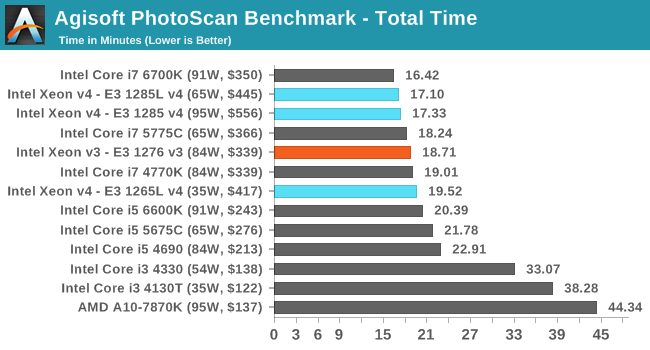
The benefits of the eDRAM here afford nearly two minutes over the v3.
Cinebench R15
Cinebench is a benchmark based around Cinema 4D, and is fairly well known among enthusiasts for stressing the CPU for a provided workload. Results are given as a score, where higher is better.
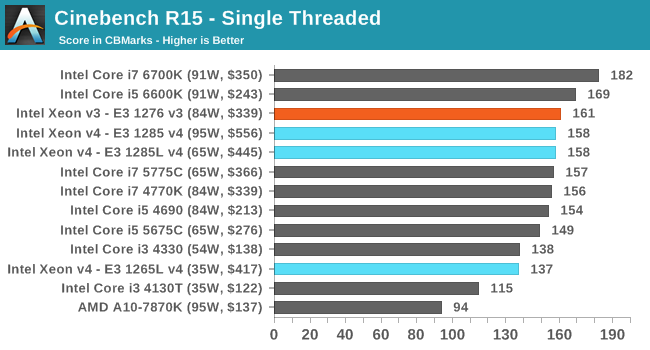

We've seen that Broadwell can organise threads slightly better than Haswell, along with its IPC increases and ability to manage more data in its buffers. As a result, while single thread is pretty much par for the course between the v3 and v4, the multithreaded result puts the v4 ahead of the v3.
HandBrake v0.9.9: link
For HandBrake, we take two videos (a 2h20 640x266 DVD rip and a 10min double UHD 3840x4320 animation short) and convert them to x264 format in an MP4 container. Results are given in terms of the frames per second processed, and HandBrake uses as many threads as possible.
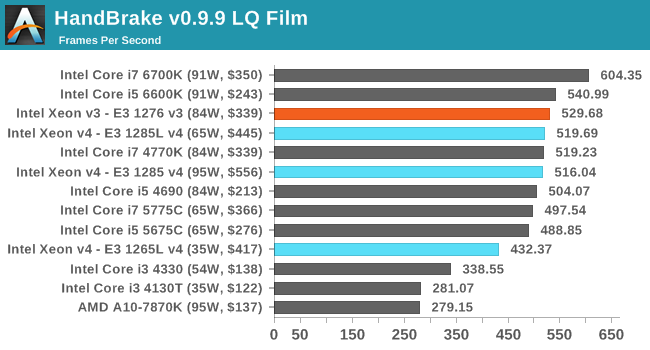
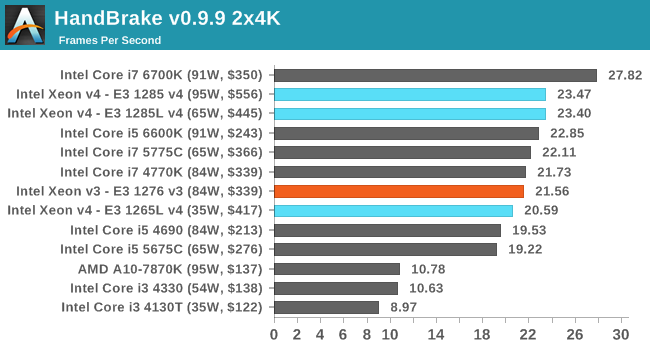
With our HandBrake tests, historically low quality encodes with small frames require a purely faster processor, whereas large high quality frames need more memory accesses. This is why the E3 v3 at 84W and E3 v4 at 35W come out near similar - the eDRAM of the v4 helps push a little ahead here. That being said, the improvements in Skylake show what perhaps the future v5 Xeons might be capable of.
Hybrid x265
Hybrid is a new benchmark, where we take a 4K 1500 frame video and convert it into an x265 format without audio. Results are given in frames per second.
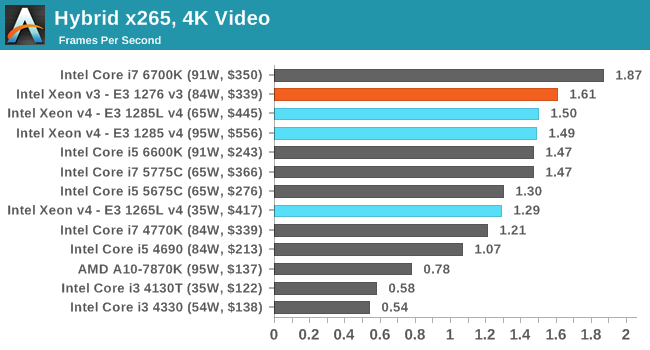










72 Comments
View All Comments
piasabird - Wednesday, August 26, 2015 - link
At $446 this isn't exactly an entry level CPU. I wonder where are the desktop CPU's with IRIS graphics like the i5-5575r which is suppose to be priced at $244 and available now but is not for sale anywhere?piasabird - Wednesday, August 26, 2015 - link
I guess Intel makes this processor but would rather have you buy a more expensive one. What is up with this? Same thing goes for i5-5675cdgingeri - Wednesday, August 26, 2015 - link
It's not meant to be a cheap CPU. It's a workstation/server chip. I has some additional data integrity features that the normal desktop CPUs can't use, like ECC memory. The drivers for the GPU are also optimized and tested for workstation level software, which is expensive to do. Sometimes, just frequency isn't enough.Camikazi - Friday, August 28, 2015 - link
I always wonder how people don't see that a server part is going to be more expensive than a desktop part. They always have been and always will be because they are binned higher and have additional features that desktops don't or can't use. Saying that $446 for this CPU is actually rather cheap for an entry level Xeon CPU and is not a bad price.Free008 - Tuesday, September 1, 2015 - link
Thats right it's too expensive. Intel will continue to gouge consumers with lower quality binned parts and disabled server features until Apple starts making decent desktop CPUs and then we can forever leave Intel and Microsoft at our leisure. Thats why none of the mobile Intel CPUs are selling - most the suppliers dont want to go back to the old monopoly days regardless of performance (which isn't incrementally significantly anymore anyway, just power savings). Intel thinks suppliers and consumers will put up with this forever but they are so wrong. It's just a matter of time now.zoxo - Wednesday, August 26, 2015 - link
It is rather disappointing that it seems that energy efficiency has regressed since the awesome 4790K. I was hoping that switching to 14nm would allow intel to do what the 88W 4790K could do in the 65W power envelope, but neither broadwell or skylake seems to be able to deliver that promise.mmrezaie - Wednesday, August 26, 2015 - link
I am also wondering why even though the performance is not changing that much but why power usage is not getting that much better!milkod2001 - Wednesday, August 26, 2015 - link
While CPU performance of the chip is only a little bit better, its GPU part is much bigger and performs much better, hence power consumption is the same as older chips. It's actually an achievement.For regular desktop CPUs i'd prefer Intel to give us native mainstream 6 core with no GPU at all.
But that would not played nicely with premium E series CPU. Money, money, money. Give me more :)
zoxo - Wednesday, August 26, 2015 - link
If you consider pure CPU loads, broadwell/skylake doesn't seem to show much power advantage over devil's canyon when you are getting to the 4GHz range. Skylake seems to be more overclock friendly, but it does consume a lot of power doing it.azazel1024 - Friday, August 28, 2015 - link
I was thinking the same thing based on Anandtech's original tests, but if you look at their notes under the delta power consumption and looking at a few other review sites, it looks a lot like motherboard manufacturers are all over the board with voltage/frequency curves for Skylake (and I assume here with Broadwell too) and it is biting them in the butt on power consumption. You've got a difference of easily 35% in power consumption from one board to the next using the same chip.Using the better numbers I have seen in some tests, Skylake, specifically the 6700k is actually significantly better than any other generation in performance per watt. Looking at the higher numbers in a few reviews, it is much worse than Broadwell and Haswell and only fractionally better than Ivy Bridge. I suspect that Skylake and probably Broadwell, that Intel's 14nm process has poor voltage/frequency scaling. Also that most motherboard manufactures are choosing poor voltage curves for the chip in an attempt to be extremely conservative.
A knock on effect here is, it is likely to be impacting actual performance too. If the 6700k has a TDP of 94w and the Dp is 110w...I'd half imagine that there is some throttling going on there with some loads.